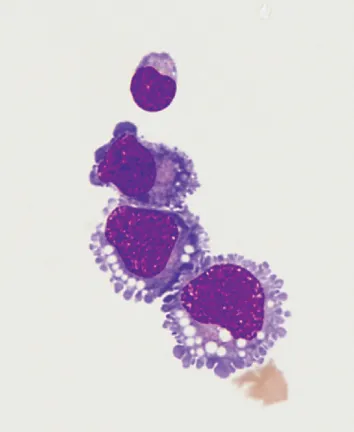
Practical Flow Cytometry in Haematology
100 Worked Examples
- English
- ePUB (mobile friendly)
- Available on iOS & Android
Practical Flow Cytometry in Haematology
100 Worked Examples
About this book
The analysis of blood, bone marrow and tissue fluid specimens requires a multi-faceted approach with the integration of scientific data from a number of disciplines. No single discipline can operate in isolation or errors will occur. Flow cytometry is in a privileged position in that it can provide rapid analysis of specimens and it is often the first definitive investigation to produce results and help formulate a working diagnosis.
This companion text to Practical Flow Cytometry in Haematology Diagnosis contains 100 worked examples drawn from real clinical cases presenting to the authors' institution. Cases are illustrated with peripheral blood and bone marrow cytology, tissue pathology and cytogenetic and molecular data, which are integrated to generate, where appropriate, a diagnosis based on the WHO Classification of Tumours of Haematopoietic and Lymphoid Tissues. The spectrum of clinical cases includes adult and paediatric patients, and both neoplastic and reactive disorders. The cases appear in no particular order to challenge the reader to make their own diagnosis.
The reader will review May?Grünwald?Giemsa (MGG)-stained films of peripheral blood and bone marrow aspirates presented alongside flow cytometric data and haematoxylin and eosin (H&E)-stained bone marrow and other tissue biopsy sections. Immunohistochemistry is used to further clarify the tissue lineage and cell differentiation. Cytogenetic studies using metaphase preparations are used to identify translocations and chromosome gains and losses whilst interphase fluorescence in situ hybridisation (FISH) studies and polymerase chain reaction (PCR) are used to identify gene fusions, gene rearrangements and deletions. Each case concludes with a discussion of the features that are important to making a diagnosis. The cases are also listed according to disease classification in the appendix so that the text can also be used as a reference.
Practical Flow Cytometry in Haematology: 100 Worked Examples:
- Provides a practical, example-based resource for flow cytometry
- Demonstrates how flow cytometry results should be interpreted and applied to optimize patient care
- Includes both malignant and benign conditions
- Can be used in conjunction with Practical Flow Cytometry in Haematology Diagnosis, by the same author team (ISBN 9780470671207)
Practical Flow Cytometry in Haematology: 100 Worked Examples is ideal for practicing haematologists and histopathologists with an interest in haematopathology, but particularly directed at trainee haematologists and scientists preparing for FRCPath and related examinations.
Frequently asked questions
- Essential is ideal for learners and professionals who enjoy exploring a wide range of subjects. Access the Essential Library with 800,000+ trusted titles and best-sellers across business, personal growth, and the humanities. Includes unlimited reading time and Standard Read Aloud voice.
- Complete: Perfect for advanced learners and researchers needing full, unrestricted access. Unlock 1.4M+ books across hundreds of subjects, including academic and specialized titles. The Complete Plan also includes advanced features like Premium Read Aloud and Research Assistant.
Please note we cannot support devices running on iOS 13 and Android 7 or earlier. Learn more about using the app.
Information
Case 1
Laboratory investigations
Imaging


Flow cytometry




Table of contents
- Cover
- Title Page
- Copyright
- Table of Contents
- Preface
- Acknowledgement
- List of Abbreviations
- Technical Notes
- Laboratory Values
- Case 1
- Case 2
- Case 3
- Case 4
- Case 5
- Case 6
- Case 7
- Case 8
- Case 9
- Case 10
- Case 11
- Case 12
- Case 13
- Case 14
- Case 15
- Case 16
- Case 17
- Case 18
- Case 19
- Case 20
- Case 21
- Case 22
- Case 23
- Case 24
- Case 25
- Case 26
- Case 27
- Case 28
- Case 29
- Case 30
- Case 31
- Case 32
- Case 33
- Case 34
- Case 35
- Case 36
- Case 37
- Case 38
- Case 39
- Case 40
- Case 41
- Case 42
- Case 43
- Case 44
- Case 45
- Case 46
- Case 47
- Case 48
- Case 49
- Case 50
- Case 51
- Case 52
- Case 53
- Case 54
- Case 55
- Case 56
- Case 57
- Case 58
- Case 59
- Case 60
- Case 61
- Case 62
- Case 63
- Case 64
- Case 65
- Case 66
- Case 67
- Case 68
- Case 69
- Case 70
- Case 71
- Case 72
- Case 73
- Case 74
- Case 75
- Case 76
- Case 77
- Case 78
- Case 79
- Case 80
- Case 81
- Case 82
- Case 83
- Case 84
- Case 85
- Case 86
- Case 87
- Case 88
- Case 89
- Case 90
- Case 91
- Case 92
- Case 93
- Case 94
- Case 95
- Case 96
- Case 97
- Case 98
- Case 99
- Case 100
- Antibodies Used in Immunohistochemistry Studies
- Flow Cytometry Antibodies
- Molecular Terminology
- Classification of Cases According to Diagnosis
- Index
- End User License Agreement